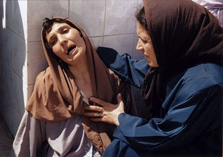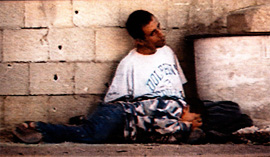Archéologie de l'architecture, de l'enfance, de l'histoire, du corps, des temps
1998 - 2005
Lamento
Lamento est un recueil de cinq textes tirés de l'ouvrage du même nom, édité par le Musée d'Art Moderne Grand-Duc Jean, (Mudam Luxembourg), à l'occasion de l'acquisition du Musée des trois sculptures de Pascal Convert autour de la question de la photographie de presse.
"Construire la durée" / "Constructing duration" / "Die Konstruktion der dauer" Georges Didi-Huberman
"Pascal Convert ou comment se dépêtrer du réel" / "Pascal Convert or how to get free of the real" /
"Pascal Convert oder wie man sich von der wirklichkeit befreit" Catherine Millet
"Eloge des aérolithes" / "In praise of aeroliths" / "Lobrede auf due himmelssteine" Philippe Dagen
"L'orphelinat des images" / "The orphanage of images" / "Das wisenhaus der bilder" Bernard Stiegler
"Passageway Images"1, by Pascal Convert
And so a day came when part of the adventure ended.
Three sculptures bear witness to this.
Thanks above all to Marie-Claude Beaud and the team at the Musee d'Art Modeme
Grand-Due Jean, but also Jean-Hubert Martin and Jean-Louis Froment.
Thanks to Georges Meri!lon, Talat Abou Rahmeh and Hocine Zaourar
for their unfailing trust and friendship.
Thanks to Eric Saint Chaffray and Claus Velte, and their patient hands.
Fatal beauty
Generally speaking, when a press photograph is described as "aesthetic", that nearly alwaysimplies "too beautiful to be true". Thus too much visual quality in a press image destroys itscredibility, its testifying power, its journalistic value. Beauty is, if anything, associated with duplicity. This very common idea is today confronted with a new situation: if the televisionimages of 9111 stick in our memory, it is because of the political and historical importance of the event, but also because of their visual beauty. How horrible to think that, you might say. But isn't it more dangerous not to think about that fasc inating beauty of destruction, a beauty that had itself been programmed by Bin Laden?
The beauty of images comes back politics
What this turn of the twenty-first century teaches us is that the return of cultural, economic and, above all, religious conflicts is accompanied by the return of the political use of the power of images, from the Taliban's destruction of the giant Buddha statues in Afghanistan to the destruction of the Twin Towers by Al-Qaida. That is why we need to look without censorship on those poor images that we consume with delight while dismissing them to the hell of mendacity. What they show us is perhaps the world not as it is but as it is becoming, putting in place the concrete and imaginary framework of historical events(2).
Originally
Three images, three icons from the last ten years were to serve us as a guide as we tried to read in the turbulence of time. But why these three images, which for so long were - and still are - accused of being no more than sets for the stagecraft of compassion? Perhaps because, sometimes, we do not give images the time to talk to us, to say to us what they have
to say. Sometimes, images stammer. Impatient, we think we have understood and we cut them off before we can hear them out.
So, three images. Two photographs from out of the night, captured in a kind of flashback of our history, the Kosovo "Pieta" by Georges Merillon (Gamma, Kosovo, 1990), the "Madonna" of Bentalha by Hocine Zaourar (AFP, Algeria, 1997) and a video sequence showing the death of "Little Mohammed" Al Dura, at Netzarim, shot by Talal Abou Rahmeh, (commentary by Charles Enderlin, France 2, 2000).
"Madonna'', "Pieta", "Lamentation of Christ", "Deposition", "Massacre of the Innocents" - these expressions from the Christian lexicon might make things easier for us.
In the end, what unities these three images may be something very simple: the compassional stereotype inherited from Christian culture. Rather than conveying the complexity of the conflicts, photojournalists tend to offer a reality that is built out of stereotypes and reflex images, in order to provide the Western consumer with images that appeal. Images that sell. And what sells is of course what we already know.
To meet this economic objective, some images imitate the archetypes of Western painting, which sometimes results in a specific photographic genre: victim photography.
This genre started to develop in the First World War and went on to produce some of the most famous images of the twentieth century: Tomoko Uemura Is Bathed by Her Mother, by Eugene Smith (Minamata, Japan, 1972) and Vietnam Napalm by Nick Ut. Such photographs were designed to induce both guilt feelings and emotion in the viewer, while reassuring them with familiar imagery.
However, starting in the 1990s, drowned in a continuous wave of uncontrollable images and duped by a series of journalistic fakes (the landing at Mogadiscio, the First Gulf War, the mass grave at Timisoara), viewers became mistrustful and enduring doubt set it. For, if "the Gulf War did not take place" (Jean Baudrillard), how could there be images of it? This doubt contaminated all images, and we started to look at them in a more distant way. But what one can see from a distance? More, can one even look, that is, be "involved"3? But what one can see from a distance? More, can one even look, that is, be "involved" (3)
The five years I spent working with these three images on sculpture projects brought me closer to them and, above all, helped me formulate some questions. How is it that in three countries with Muslim cultures: Kosovo, Palestine, Algeria, and at three different dates: 1990, 1997 and 2000, we find the same Christian iconography of the martyr?
Looking at these three images from Muslim culture, we are facing martyrdom inflicted, the martyr as suffering victim.
Above all else, they confront us with the suffering of the other, with Muslim suffering, with the fate of Muslims in the contemporary world. What we refuse to see comes back with a vengeance, even if we tame it by imposing a Christian reading.
But these three images were, to diverse degrees, instrumentalised by Muslim fundamentalists, which was a sign that, between 1990 and 2001, radical Islamic movements had begun to understand the point of counterbalancing the iconography of the offensive lslamist martyr(4), the human bomb, which is not likely to be understood in the Western world, with the iconography of the passive martyr, which is more likely to arouse compassion.Thus the history of these three images can be seen as the story of a gradual dispossession of our culture, with the West looking on powerlessly as its iconography of the victim was colonized for the purposes of Islamist propaganda; with the West looking on powerlessly at the planetary circulation of images whose meaning it fails to decipher because it does not confront it (for these images do confront the West)(5).
9/11 saw the apogee of this dispossession: the United States looked on dumbfounded at the destruction of the symbols of their economic domination, of this world where "there is a kind of asphyxia of speech, because the words there are exchanged indifferently, are all alike, like coins"(6).
But this destruction of the Babel Towers of the globalised economy was also the destruction of the United States' visual domination by the simple inj ec tion of the imaginary world of disaster movies into the real, at the heart of the megacity. Faced with this disaster, the American authorities rushed to transform the ruin of metal flesh into a glass ghost, in the belief that they could thus destroy the images of destruction. Here was a simple admission of disarray, of the fear of a symbolic domain that was no longer under control.
It is the story of this dispossession that these three images tell. And this being dispossessed of one's self, of one's identity, points to a crisis not of Islam but of the West. The accusations levelled at these three images, condemned here as vestiges of colonialism, there as propaganda images originating in extremist Islamist movements, and even as pure and simple stagings(7), are the first symptoms of an identity crisis in Western society, of a crisis in its relation to images.
Pascal Convert
1 - Ce texte est inspiré d'un article publié dans un numéro spécial d’Art Press «Images et religions du livre» (novembre 2004). Il fait suite à trois articles parus dans Art Press : "Des images en mercure liquide" in n°251, nov. 1999, "Des images figées" in hors série "Représenter l'horreur", mai 2001 et "Médée l'algérienne" in n° 289, janv. 2003.
2 - Entretien entre Catherine Millet et Pascal Convert in "De Mémoires" , catalogue de l'exposition organisée par Philippe Dagen au Studio National du Fresnoy, Tourcoing, 2003, éd. Flammarion.
3 - Georges Didi-Huberman in "L'image brûle", conférence au Centre Georges Pompidou, juin 2004.
4 - Farhad Khosrokovar, Les nouveaux martyrs d'Allah, éd. Champs Flammarion, 2002.
5 - Georges Didi-Huberman. Ce que nous voyons, ce qui nous regarde, éd. de Minuit. 1992.
6 - André Neher, L’Exil de la Parole, éd. Seuil, 1970, p.114.
7 - On accusera par exemple La Madone de Benthala d'être un photomontage. Mais les accusations de mise en scène toucheront plus directement la scène de la mort de Mohamed Al Dura. Gérard Huber dans son livre Contre-expertise d'une mise en scène (éd. raphaël. 2003) parle de "mise en scène palestienne de la fausse mort de l'enfant palestinien (...)" p 222. On peut lire sur cette question mon texte "Des images figées" in: Art Press, hors série "Représenter l'horreur", mai 2001.
/ Accueil /
Biographie / Oeuvres / Expositions / Films / Thématiques / Documents
Textes - articles / Editions / Liens - contact / Au hazard



